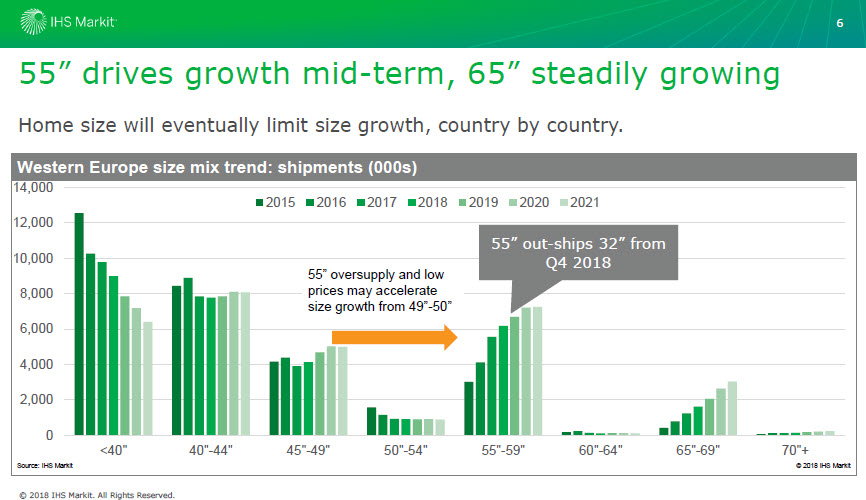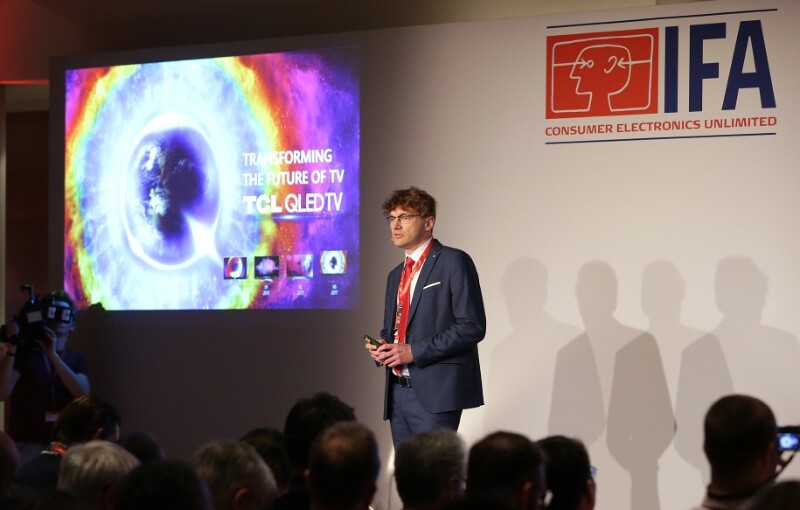IFA hosted its Global Press Conference in Rome and a highlight was the formal release of the Sharp 70″ 8K monitor (Sharp 8K Monitor Now in Europe). Of course, there is not going to be much content very quickly. NHK will have at least six hours per day of content by the end of the year.
In an interview, Paul Gray of IHS nicely categorised 8K (which needs around a 70″ display or more) 8K TV as ‘IMax for the home’ as it really needs to almost fill the visual field to get the benefit. Of course, larger sizes are getting more popular, with average sizes growing even in regions such as Western Europe, which has been conservative. By the end of 2018, 55″ will outship 32″ in Western Europe for the first time.
 Western Europe TVs by size – 55″ goes past 32″ Source:IHS
Western Europe TVs by size – 55″ goes past 32″ Source:IHS
Paul Gray of IHS Markit characterised 8K as ‘IMax for the home’. Image:IFA GPC
Also at the event, TCL set out that, like Samsung, it is very committed to developing QD TVs. In an interview with HDTVTest, Gray said that his firm had thought that Samsung would introduce QDs on Filter somewhere in 2019 or 2020, however, the company is now hearing ‘stories from Korea’ that Samsung may be skipping that technology to try to move to LED with QD or direct QD displays. Gray also said that he expects to see inkjet-printed OLED displays within five years (we assume he meant in mainstream TVs, rather than in niches). He also said that LG Display’s next G8.5 fab could efficiently make 48″ in a couple of years, so that might be a size that LG could make.
Gray believes that a well executed FALD LCD can give performance that is very close to OLED, especially in other than cinematicly dim conditions.
Also at the event, TCL said that it is aiming to target a ΔE error of less than 1 in SDR, and a ΔE error of less than 3 for HDR, which is possible because of the higher colour volume of LCD compared to OLED. TCL is focusing on Android-based TVs in Europe, rather than the Roku-based sets used in the US, which have a different chipset. The company said that the use of Android is the main reason it doesn’t currently sell sets in the UK, but will do so later in the year when it introduces Linux-based sets that can support FreeView Play and other UK services.
At the moment, because of the differences in chipset, TCL supports Dolby Vision in the US, but not in Europe, but support of Dolby Vision in Android TVs is expected to change that in 2019.
 Marek Maciejewski of TCL at the Power Briefing. Image:IFA GPC
Marek Maciejewski of TCL at the Power Briefing. Image:IFA GPC

